July, 2005 ![]() Page 12
Page 12
by Dan Fink (Meet the Writer after this article)
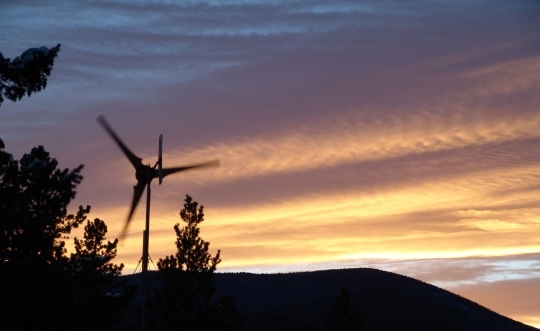
This article was orginally published in the July 2005 issue of the Energy Self Sufficiency Newsletter. DanF writes a monthly wind power column for the ESSN, and we at Otherpower.com highly recommended this publication for anyone interested in renewable energy. The ESSN focuses on homebrew and do-it-yourself projects instead of the expensive turnkey installations seen in many other magazines. Best of all, it's free! You can download both the current issue and back issues HERE.
Wind power is taking off in a big way worldwide, in both giant utility-scale installations and small-scale turbines intended to power a single home. Remote off-grid dwellers are finding wind power an excellent supplement to solar during cloudy weather, and enjoying the extra freedom that more power input gives, especially after dark or during cloudy weather. On-grid folks are installing home wind turbines to offset rising power costs, and even selling extra power back to the utility.
Judging from the volume of questions I receive about wind power, there are many misconceptions amongst people out in the real world. Even though the physical laws and formulas governing wind power have been well understood for over 150 years, it has taken new fears about falling oil production, rising gas prices, and global climate change to generate the growing interest in wind power we have now with the general public. In this first article of the series, I’ll attempt to explain the basics of how power is extracted from the wind, to help readers understand how much power they could expect from turbines of different sizes. Future parts of this series will cover many other small wind topics.
Photo by Tim Fecteau
How small wind turbines work
A wind turbine extracts energy from moving air by slowing the wind down, and transferring this harvested energy into a spinning shaft, which usually turns an alternator or generator to produce electricity. The power in the wind that’s available for harvest depends on both the wind speed and the area that’s swept by the turbine blades.
Caution: Mathematics ahead! But it’s pretty simple, and if you are armed with a pocket calculator and some simple formulas and concepts, you should be able to make a wise choice in selecting a wind turbine, and be able to reject unsuitable products and detect scams. I apologize in advance for mixing metric and standard units!
 2
2
E=MC
July, 2005 ![]() Page 13
Page 13
Power available in wind (in Watts)
=
½ * air density swept area wind velocity3**
where
air density
=
1.23 kg per cubic meter at sea level (1.0 here in Colorado)
and
swept area is in square meters
wind velocity is in meters per second If we work the formula for a 5-foot diameter turbine in a 10 mph wind:
5 feet = 1.524 m swept area = pi * r2 = 1.8241m2 wind Speed = 10 mph = 4.4704 m/s So
Power available (Watts) = ½ * 1.23 * 1.8241 * 4.47043
=
100.22 Watts
The first key concept that this formula shows is that when the wind speed doubles, the power available increases by a factor of 8. That means there’s very little power available in low winds. Increase the wind speed for this 5-foot rotor to 20 mph (8.9408 m/s) and we get:
Power available (Watts)
= ½ * 1.23 1.8241 8.94083
** =
802 Watts
The only way to increase the available power in low winds is by sweeping a larger area with the blades and that’s the second key concept from this formula. Power available increases by a factor of 4 when the diameter of the blades doubles.
If we use a 10-foot (3.048 m) diameter rotor for a 7.30 m2 swept area in a 10 mph wind, we get:
Power available (Watts)
= ½ * 1.23 7.30 4.47043
** =
401 Watts
and in a 20 mph wind:
Power available (Watts)
= ½ * 1.23 7.30 8.94083
** =
3209 Watts
However, there’s no way to harvest ALL of this available energy and turn it into electricity. In 1919 a gentleman named Betz calculated that there’s a limit to how much power a turbine blade can extract from the wind. Beyond the Betz Limit of 59.26% energy extraction, more and more air tends to go around the turbine rather than through it, with air pooling up in front. So 59.26% is the absolute maximum that can be extracted from the available power.
There are additional losses after Betz. Small wind turbine blades are never 100% efficient, even when running at their favorite speed. No alternator or generator is 100% efficient in converting the energy in a rotating shaft into electricity. There are friction losses from bearings, and from any gearing that’s involved in the power conversion. And there are magnetic drag and electrical resistance losses in the alternator or generator.
Wind power researcher Mike Klemen did some volunteer math to benefit the wind power community, and came up with a web page about the Perfect Turbine:...............................
http://www.ndsu.nodak.edu/ndsu/klemen/Perfect_Turbine.htm
A “perfect turbine” would work right at the Betz limit, the blades and the alternator would match perfectly at all wind speeds, and the alternator would have no internal magnetic or electrical losses. Klemen also averaged the efficiency of power conversion (called the “Coefficient of Power”, or Cp) of several commercial small wind turbines, and got the figure of Cp=35% for what he calls on his page a “Good Turbine” , though none of the commercial turbines he tested were able to reach that efficiency.
So now you are already armed with the knowledge to detect a wind power scam or a misleading advertisement and there are some out there. Caveat Emptor (Buyer Beware), and TANSTAAFL (There Ain’t No Such Thing As A Free Lunch
-Robert Heinlein). If an advertisement claims more poweroutput than is even available in the wind, you are dealing with a con artist. If the power output claims beat Betz, you are either dealing with a mis-informed individual or company, or a con artist. And if output claims exceed Klemen’s very optimistic Cp=35% guideline, you may have found an exceptionally good turbine, or more likely someone who is not measuring Cp carefully enough with their data acquisition equipment. Though giant utility-scale turbine designers are attempting to close the gap between reality and Betz, a small turbine that gives a Cp of 35% or more would be considered an exceptionally good design right now.
Continued on next page
July, 2005 ![]() Page 14
Page 14
Average Wind
Another crucial concept to understand about wind power is at what speeds the wind usually comes to us for harvest. Folks that are new to wind power tend to think that if they put up a small, 4-foot wind turbine that’s rated 400 watts, they’ll be getting 400 watts power input whenever it gets breezy outside. In reality, at most locations the wind comes to us at low speeds 5-15 miles per hour. And we’ve already learned that low winds don’t have much power in them, and that they can only make useful power when swept with a large rotor. Advertised wind turbine “ratings” are currently all based off of peak output in high winds which are relatively rare. Much more important is what the turbine will do in low winds, but this information can only be extracted from power curve charts supplied by the manufacturer.
It’s easy to look up the average wind speed at your geographic location with the NREL (National Renewable Energy Laboratory) printed and online Wind Resource Atlas:............... (http://rredc.nrel.gov/wind/pubs/atlas/). It will show you your “wind zone” and the average wind speed in that zone. It’s a good way to see if wind power is even appropriate for your site, but doesn’t give you all the information you need to select a turbine for your location and power needs.
The statistics used to calculate the distribution of wind speeds are complicated, but the results are easy to understand. In most locations worldwide, the distribution of wind speeds keeps fairly close to a Weibull or (simplified) Rayleigh distribution of wind speeds, shown below. There are non-Rayleigh locations where the curve takes on other shapes, but these are relatively rare. The distribution shown here is relatively common.
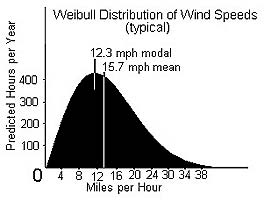
In the chart, the horizontal axis shows wind speed, and the vertical axis the probability (which can be condensed down to the predicted number of hours per year) that the wind is blowing at that speed. The area under the graph is always equal to one, because the probability that the wind is either blowing or not blowing is always 100%.
An anemometer is an extremely valuable tool for evaluating your location for wind potential. Anemometers can be rented, built at home, or purchased. Some models even plot your Weibull distribution for you. See the links at the end of this article for more anemometer information and resources.
These concepts are the key to selecting the correctly sized wind turbine for any application select your turbine based on the SWEPT AREA, not the manufacturer’s “rated output.” Rated output is an almost meaningless figure, it’s simply the peak power the turbine can make in high winds. But at what
One of Otherpower.com’s 10-foot turbine designs in operation. This one was built and flown by our neighbor Tim Fecteau. The web page about the design is at https://www.otherpower.com/timsturbine.html/
wind speed does it make that rated power? Most manufacturer rated outputs are taken at around 28-30 mph. And for how many hours per year do you get wind at that high speed? In most locations, very few. Most winds come in at a much lower speed, and therefore have much less power available in them. The only way to compensate is with a bigger swept area. Continued on next page
July, 2005 ![]() Page 15
Page 15
In a 10 mph wind (very common), there are 100 Watts of power available with a 5 foot diameter wind turbine. Betz lowers this to 59.26 Watts, and with Klemen’s “good” turbine losses we are down to at most 35 watts of output. That’s only enough power to fire up a couple of efficient CF light bulbs. By comparison, a 10 foot turbine has 401 Watts available, 238 W with a “perfect” turbine, and 140W output in an excellent turbine design. Much better, but not anything that’s going to make your electric meter run backwards! A “good” 20-foot turbine could possibly give 740W at 10 mph.
When we double the wind speed to 20 mph, the exponential increase in power available becomes apparent 280 possible Watts from a “good” 5-footer, 1,100W from a 10-footer, and 5,900W from a 20-footer. Now we are talking some real power for a sailboat or cabin (the 5-foot machine), an off-grid home (the 10-foot machine), or an on-grid house trying to offset the power bill (the 20-foot machine). Of course it varies by location, but on a good wind power day that most people would call breezy, the wind will usually be between 10 and 20 mph.
Now you are armed with some realistic expectations of how much power different sized turbines can make at different wind speeds. You should be able to whip out your pocket calculator at any time and envision how much power is possible. And here’s where some less scrupulous retailers and manufacturers try to promote wind power misconceptions to boost sales but now you are immune to hype! Some examples are listed below, and each future part of this series will have some hype-proof and misconception-busting information related to its topic. These examples are all fictional but you’ll find great similarities to real ads if you prowl Ebay and Google for wind turbines.
400 Watt Wind Turbine only $500! More power than $1,600 worth of solar panels! No Reserve! That 400 Watt wind turbine rating will be peak output, probably in 28-30 mph winds. Check your Rayleigh distribution chart, and estimate how many hours per year that you’ll see 30 mph winds. Not many! While in the meantime your 400 Watts of solar panels will be making the full 400 Watts for many hours per week. Comparing solar to wind is like comparing apples to oranges. A good renewable energy system will use BOTH solar and wind.
This remarkable innovation can make 3,000 Watts of power in 13 mph winds, all from an unobtrusive 6 by 6 foot box! Get out the calculator, and you’ll see that they are claiming over 7 times more power output than is even available in the wind. It’s a scam for sure, because it defies the laws of physics.
Don’t want a big, unsightly wind turbine in your yard? Buy 3 of these small, 400 Watt turbines, and get as much power as a big, ungainly and expensive 1,200 Watt unit for half the price! Think back about power available in the wind and its factor of 8, and swept area and its factor of 4. At the rare rated peak output, which is probably around 30 mph, the 3 small 400W turbines might indeed be making near the same power as one big 1,200W model. But what about performance in your far more common low winds? The large turbine would be spinning and making some power, while the small ones most likely sit still, making nothing.
900 Watt Wind Turbine! Under 3 feet in diameter!! No Reserve!!! A quick check with pocket calculator shows some problems. Running the power available in the wind equation at 30mph, even Klemen’s exceptionally “good” turbine guideline gives only 600 Watts output with a 3-foot rotor, so something is fishy here. A quick check of the turbine’s specs shows that that that 900W rating is for 65 mph winds?”which are extremely rare. Commercial turbines are all given their ratings at around 30 mph that seems to be the industry standard.
This last example of hype again shows exactly why you should select a wind turbine based on swept area and not rated power output. There has been much controversy and discussion on the internet recently regarding rated output, since folks that are flying wind turbines can observe with their own power meters how useless peak power ratings at 30 mph really are, and how infrequently that output level occurs. The problem is that wind turbines manufacturers NEED some way to quickly and easily present their performance data to the public.
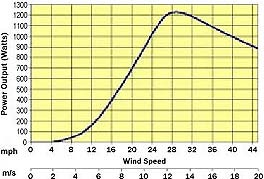
Sample power curve diagram: Wind turbine instantaneous power curve chart from a very reputable manufacturer. This one is for a Bergey XL.1, an 8.2-foot diameter, 1,000 Watt machine. Chart source: http://www.bergey.com/.
Continued on next page
July, 2005 ![]() Page
16
Page
16
For example, I could rate a nice 10 foot turbine at only 400 Watts, and that would very accurately reflect what it can make in common 15 mph winds. But no one would buy it, since they could get a 400 Watt turbine with only a 4-foot diameter from another manufacturer for a fraction of the cost and are not aware that the turbines are rated at vastly different windspeeds. The 10-footer would make far more power in all winds and far more power per year, but by comparing the peak output data the uninformed buyer would assume they would perform the same. Really, the only way to accurately rate wind turbines is by comparing their measured power curves, and most consumers are not willing to sit down and crunch the math.
Swept area is the most important concept in choosing a windturbine, but it’s very difficult to get that concept across to an under-informed public.
Hopefully YOU now understand some of the issues involved in figuring how much power is available in the wind with different sizes of wind turbines. The next article in this series will cover the details of why wind turbine blades are shaped as they are, how electricity is generated by that spinning shaft, and how wind turbines regulate their output and protect themselves from extreme winds. Remember that factor of 8 increase in power when wind speed doubles? This massive increase in power can blow a wind turbine apart, and the turbine design must be able to compensate to keep incoming power at a reasonable level.
Dan Fink
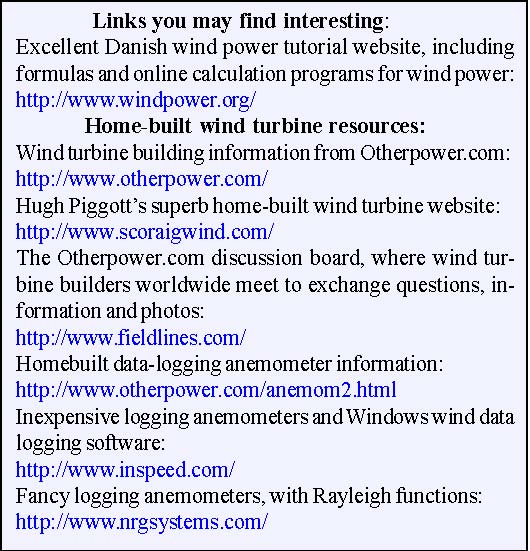
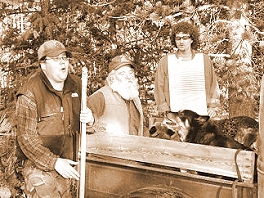
The article on Wind Power that you have just read was written by Dan Fink, seen here top left playing the Washtub Bass and vocalizing in enthusiastic harmony with his fellow members of the Dog Mountain Band ( http://www.DogMountainBand.com/ ).
Dan Fink is not just a skilled musician, playing the Banjo, the Dobro guitar and the Kazoo in addition to the Washtub Bass, but in his spare time is the technical director for Forcefield in Fort Collins, Colorado, USA ( https://www.otherpower.com/
and. http://www.wondermagnet.com/ )
He has lived off-grid, 12 miles from the nearest power or phone pole, for 14 years, and maintains Forcefield’s websites and servers via a satellite internet connection. His home is powered entirely by solar and wind, so he knows what he is talking about!.
Dan’s articles have appeared in such magazines as Back Home, Home Power, and Zymurgy. In his spare time, Dan is a volunteer firefighter for the Rist Canyon Volunteer Fire Dept. ( http://www.rcvfd.org/ )
How he finds time to write for us is a mystery!

Discuss this article on the Green-Trust forum
